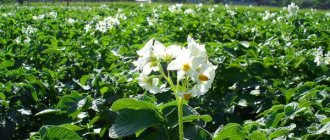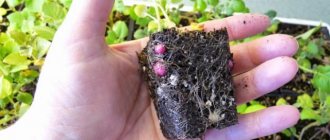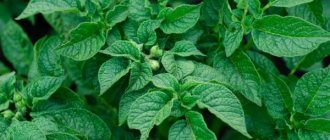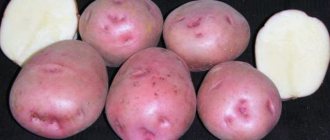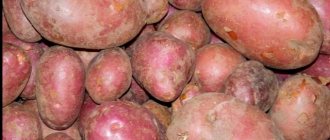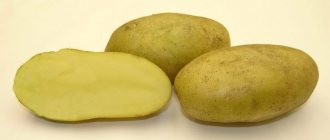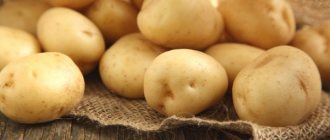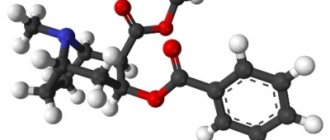For a long time, the Russian people sought to displace their product (Kolobok, Sineglazka potatoes, etc.) and plant a good Dutch variety. But, over time, people began to understand that in most cases the vaunted Dutch potatoes are no better than their domestic product. Therefore, recently, in the Russian markets, domestic varieties have gradually begun to displace foreign “spies”. And in this article I would like to talk about one very tasty and productive Belarusian variety - Yanka potatoes.
Description of the potato variety Yanka
Yanka is a new hybrid table potato variety of Belarusian selection. The priority during its hybridization was the creation of a high-yielding frost-resistant crop. After experimental research in 2012, it was included in the State Register of varieties allowed for cultivation in the Central and North-Western regions of Russia.
Important! The State Register of Breeding Achievements is a collection of information about plant varieties and animal breeds registered in the Russian Federation. Based on tests, they are zoned by region in order to highlight the categories most suitable for cultivation in a particular area.
Description of the characteristics of the Yana potato variety:
- The bush is of medium height, about 60 cm, moderately spreading, leafy, has a semi-erect main stem and about 7 shoots.
- Medium-sized matte dark green potato leaves of an open type, with a lowered plate and a wavy edge.
- The corollas of the flowers are white and small. The inside of the petals may have a light anthocyanin (blue-violet) color. The middle of the flowers, collected in inflorescences of 8 pieces, is bright orange. They pollinate naturally and drop quickly.
- The plant almost never produces berries.
- The bush produces up to 12 oval-shaped tubers, weighing 80 - 105 g. They lie at a shallow depth.
Photos and descriptions of Yanka potatoes allow you to get an idea of the culture:
Potato care
The soil, especially wet and heavy soil, must be loosened within a week from the moment of planting. At a summer cottage, a rake or hoe is suitable for these purposes. Thanks to loosening, air circulation will improve, and sprouts will appear on the surface much earlier.
Young plants that have reached a height of 15 cm need to be hilled. The first hilling will prevent the bushes from falling apart and will make them grow rapidly upward. After 2 weeks, Yanka potatoes are hilled a second time. In order for the rhizome to grow and tubers to form, a high mound must be placed around each plant. The hills are sometimes washed away by rain. If such a nuisance occurs, this is a reason for a third hilling.
https://youtube.com/watch?v=ra5W5Xx0taM%3Fstart%3D33
Characteristics of the Yanka potato variety
Important! The Yanka variety is classified as mid-late. Such potatoes reach maturity 95 - 120 days after planting. The timing of its harvesting falls during the warm, dry weather of Indian summer (September 10 - 24).
The Yanka variety is adapted for cultivation in many climatic zones, including regions with unfavorable weather conditions. It is resistant to late spring return frosts. Potatoes do not need frequent watering. Without it, in the cool climate of the northern regions you can get a bountiful harvest. The crop is immune to many potato diseases and pests.
Potato tubers of the Yanka (Yana) variety have characteristic features. Their surface is smooth, without bumps, the peel is yellow, strong, weakly reticulated. The tubers have small, uncolored eyes with pinkish buds, and the flesh is white or light cream in color. The starch content in it reaches 18%. Tasting score – 4.8.
Comment! Due to the fact that the tubers are approximately the same in size, mechanization can be used for harvesting.
A distinctive feature of the tubers is the absence of darkening of the flesh on the cut of raw potatoes, despite the high starch content. It also does not darken during heat treatment.
According to numerous reviews, Yanka potatoes have a pleasant taste, do not become soggy when cooked, and become crumbly. It is suitable for preparing first courses, side dishes, fillings for pies and dumplings. It can be boiled, fried, stewed, baked. On an industrial scale, it is used to produce chips, instant purees, and semi-finished products. Vacuum sealing methods can be used to store raw peeled potatoes.
Productivity
One of the most important properties of potatoes is yield. The table shows some indicators characteristic of the Yanka variety:
| Index | Meaning |
| Productivity, c/ha | 200 – 320. |
| Number of tubers per bush, pcs. | 8 – 12. |
| Average weight of tubers, g | 106. |
| Presence of small items and non-marketable tubers in the nest | minimum, up to 5%. |
| Marketability | 80 — 95 %. |
| Keeping quality without germination | high, 96%. |
| Transportability | high. |
Advantages and disadvantages
One of the main advantages of the crop is due to its varietal characteristics. Thanks to the late planting and slow development of the plant, potatoes are not subject to return spring frosts, which made its cultivation acceptable in the Central and Northwestern regions. Reviews of the Yanka potato variety contain a description of its other advantages:
- high quality and taste of tubers;
- good yield indicators;
- cultivation on personal plots and on farms;
- possibility of mechanical harvesting;
- long-term storage without loss of presentation;
- endurance to overloads and transportation;
- tolerance to short-term adverse weather conditions (frost, heat, drought, prolonged rains);
- immunity to potato golden cyst nematode and diseases caused by viruses X, Y, M, L;
- stability of varietal characteristics of seed material in several reproductions.
Advice! Potato seed material must be periodically renewed to prevent degeneration of the variety's properties.
Belarusian interns have developed a variety that has virtually no disadvantages. In the descriptions of Janka potatoes, one can find some negative aspects that manifest themselves in its susceptibility to black scab and potato virus S. They can be compensated by the use of plant protection products against these diseases. In addition, the plant does not tolerate high soil moisture and is susceptible to attacks by the Colorado potato beetle.
Characteristics of the root crop
The tubers of the Yanka variety are uniform, very beautiful, and have the following characteristics:
- the shape of the root crop is elongated oval or round oval;
- weight of 1 potato from 80 to 106 g;
- peel slightly reticulate, medium-thin, yellow;
- the pulp is creamy, rich in vitamins, amino acids and protein;
- starch content up to 18%;
- there are few shallow, uncolored eyes.
Despite the moderate starch content, the potatoes cook poorly and become crumbly. The pulp does not darken during processing. Summer residents who grow Yanka potatoes characterize it as a very tasty variety suitable for sale. As for use in cooking and industry, it is suitable for almost all dishes and various types of processing.
Landing rules
Reviews from potato growers include extensive characteristics of the rules for planting potatoes of the Yana variety. They relate to timing for different regions, requirements for soil and seed material, and planting order.
Recommended timing
Potatoes of the Yanka variety are recommended to be planted at a time when the soil warms up by at least 6 - 8 0C to a depth of 8 - 10 cm, which is achieved at air temperatures above 15 0C. For the Central and Northwestern regions, this period is no earlier than the second half of May. In areas located further south, planting can be carried out in late April - early May.
Advice! Soil temperature can be measured with a regular thermometer. A popular sign that the soil has warmed up sufficiently for planting potatoes is the active behavior of earthworms in the soil. According to the lunar calendar, crops are planted on the waxing Moon.
Soil preparation
For planting, choose a well-lit area. In shaded areas, the size of tubers decreases. Obtaining an abundant and high-quality harvest of Yanka potatoes is possible by following the rules of crop rotation when choosing a planting site. The predecessors of the crop on the site can be meadow grasses, legumes, carrots or cabbage.
Important! Every three years, the location where potatoes are planted is changed to prevent infections.
The Janka potato variety is adapted to a wide range of soils. But it is preferable to grow it on light, loose soils characterized by an average granulometric composition (sandy loam and light loam).
Advice! It is recommended to prepare the soil for planting Yana (Yanka) potatoes in the fall.
Preparing land for potatoes includes the following steps:
- Digging the soil and removing weeds.
- Neutralization of acidic soils by adding lime or dolomite flour.
- Uniform distribution of compost over the soil surface.
In the spring, before planting Yanka potatoes, the soil is dug up again and saltpeter is added. It should be borne in mind that an excess of nitrogen fertilizers in the soil negatively affects the quality of tubers. In order to prevent diseases and damage by pests, the crop is treated with disinfectants.
How to plant correctly
A prerequisite for achieving high results in planting and growing Yanka potatoes is properly prepared healthy seed material. When collecting it yourself, you cannot select tubers for seeds from a bush in which at least one diseased-looking potato was found. When purchasing, many gardeners give preference to Elite and Super Elite class planting materials that are affordable and of good quality.
Tubers before planting:
- carefully inspect for rot and damage, calibrate by size;
Advice! Potato tubers of the Yanka variety intended for planting should weigh 30 - 90 g. They should not be cut before planting. - planted in a well-lit place at a temperature of 12 0C for disinfection and prevention of damage by rodents;
- additionally treated with a growth stimulant, for example Poteytin, Bioglobin or Epin;
- spread in one layer and germinate for a month in a bright, ventilated room.
Important! Sprouted tubers cannot be treated with stimulants and disinfectants.
The appearance of a potato tuber of the Yanka variety properly prepared for planting is shown in the photo:
You can plant Yanka (Yana) potatoes, depending on the properties of the soil and the personal preferences of the gardener, using any of the methods:
- trench;
- nesting;
- on the ridges;
- on the ridges.
When planting, regardless of the chosen method, adhere to the following recommendations:
- Make planting holes 20 cm deep at a distance of 35 cm with an interval between rows of 50 cm.
- To increase the nutritional value of the soil, humus or wood ash is added to the holes.
- Potato tubers are carefully placed in holes in pairs at a distance of 7 cm from each other, avoiding damage to the sprouts.
- The seeds are sprinkled with a mixture of ash and peat in a layer of 5 cm.
- Holes or trenches are covered with earth and not watered.
- The soil can be mulched with hay or sawdust to retain moisture.
Attention! When industrially growing potatoes of the Yanka variety, the planting density is 45 - 48 thousand tubers per hectare. For growing seed material, it is recommended to adhere to the figure of 52 - 55 thousand tubers per hectare.
Advice! Using a manual potato planter helps make planting easier and faster at home. You can do it yourself.
Necessary conditions for good growth and productivity
For successful cultivation and obtaining a healthy and rich harvest, it is necessary to create conditions for growing the crop.
Climatic conditions
For the Yanka variety, temperate climatic zones are considered the most optimal. In the south, the variety requires increased watering. In the north, potato yields are declining. It is necessary to take this into account when choosing a variety for your site.
Humidity, temperature, light
The Yanka variety loves moisture, but does not tolerate flooded soils and stagnant water. Therefore, it is necessary to choose places that are not exposed to high moisture content in the soil.
The optimal temperature for growing potatoes is considered to be 20 – 24 °C. As temperatures rise, it is necessary to increase watering and delay harvesting by 1–2 weeks. When temperatures drop and there is frequent rain, crops are dug up earlier and watering is reduced.
Illumination for potatoes should be at least 8 - 10 hours a day. No shadow should fall on the planting site. Constant weathering of the bushes will also deteriorate the quality of the fruit.
Recommended soil composition
The best soils are sandy and sandy loam. On clayey and loamy soils, it is recommended to install drainage. The optimal soil composition is considered to be:
- peat;
- sand;
- humus.
See also
Description and characteristics of Lorch potato varieties, planting and care
Read
Features of cultivation
Characteristics of the characteristics of growing potatoes of the Yanka variety and reviews from farmers emphasize the need to comply with the rules of agricultural technology, watering schedules and fertilization.
Watering schedule
If there is sufficient rainfall, Janka potatoes do not need watering. But if there is not enough rain, it is watered twice according to this schedule:
- 14 - 15 days after emergence;
- during budding and flowering bushes.
Watering is carried out in the evening at the root or along the furrows at the rate of at least 3 liters of water per bush.
Loosening, weeding, hilling
The rules of agricultural technology for potatoes of the Yanka variety require maintaining the soil in a loose, breathable state. It is loosened from the fifth day of planting. It is necessary to regularly weed the weeds, as they are a source of disease and compete with the crop for nutrients.
Important! Weeds are removed by the roots and removed from the garden bed.
Two or three times during the season, the bushes are hilled to form high ridges. The higher the Yanka potato is hilled, the better its harvest. The event takes place in the morning or evening. The optimal time for the procedure is after rain.
Hilling can begin when the sprouts have reached a height of 14 - 20 cm. Early hilling serves as protection against return frosts and replaces weeding and loosening. Potatoes of the Yanka variety are re-hilled before flowering. If the tops of the bushes fall apart and the tubers come to the surface and begin to turn green, the process is repeated. The last hilling is done before the tops close.
Important! Closing of the tops is the visual disappearance of the spaces between the rows of potatoes as their crown grows.
Advice! You can reduce the labor intensity of the hilling process by using a modern cultivator.
Do I need to feed
To increase yield, Yanka potatoes are fed with urea and phosphate. These fertilizers are applied 20 - 30 days after planting. During flowering, plants can be fed with potassium sulfate or a solution of bird droppings. At the stage of tuber formation, it is recommended to treat the bushes with superphosphate. Fertilizing is combined with watering the crop.
Attention! If the soil is properly prepared for planting, there is no need to additionally feed Yanka potatoes with fertilizers.
How to care for crops in open ground
Yankee potatoes are not demanding in care, however, to improve the quality of the crop, it is necessary to carry out weeding, watering, fertilizing, hilling, and protecting the crop from diseases and pests.
Watering and fertilizing
Potatoes are watered three times during the growing season. The first time is when the plant reaches 15 - 20 cm in height, the second time at the beginning of flowering, and the third after flowering has completed. One plant uses 3 liters of pre-settled water. The liquid is applied to the root area of the bush.
Loosening and weeding
Loosening the soil ensures that the tubers are saturated with oxygen. The procedure is carried out after each watering and rain. This prevents the formation of earthen crusts and promotes improved absorption of minerals.
Along with loosening, weeds are removed. If the beds are overgrown with foreign plants, this will affect the quantity and quality of the harvest.
Hilling
Hilling improves the formation of root crops and helps increase their number. The manipulation is carried out three times per season. The first time is when the plant reaches 20 cm in height, the second two weeks after the first, and the third three weeks after the second.
See also
Instructions for use of "Bushido" from the Colorado potato beetle, processing rules
Read
Important! The plant is sprinkled with soil so that 3–4 pairs of leaves remain on the surface.
Diseases and pests: control and prevention
The crop is susceptible to infection and attack by harmful insects. With frequent rains, unfavorable weather conditions and failure to follow the rules of care, the bushes become sick more often. They are struck by:
- late blight;
- fusarium;
- scab;
- Alternaria blight;
- blackleg;
- nematode.
To combat infections, damaged areas of the plant are removed and the bushes are sprayed with fungicides. To prevent infection, treatment is carried out before flowering and repeated 2 times per season.
The crop is also susceptible to insect attack:
- Colorado potato beetle;
- wireworm;
- bear;
- black aphid.
To combat insects, spray with a wide spectrum of insecticides. At the end of the drug's effect, the treatment is repeated. Treatment is stopped 20 days before harvest. It is during this period that chemicals are broken down.
Pests and diseases
The Yanka variety is resistant to most diseases, except late blight. To prevent it, bushes are sprayed with copper-containing preparations.
Pests that threaten Janka potato plantings are:
- Colorado beetle;
- mole cricket;
- potato moth.
Insects are gotten rid of using folk methods or methods of chemically treating potato bushes with insecticides (Antizhuk, Colorado Forte). Spray the beds in dry, windless weather, observing safety rules.
Important! In order to prevent diseases and pest damage, Yanka potato plantings are regularly inspected for damage and insects.
Harvesting
The duration of storage of Yanka potatoes is determined by the harvest time and the rules for its implementation. Unripe root vegetables have an underdeveloped skin that is unstable to mechanical damage. Overripe tubers lack marketable appearance and taste. The optimal time for harvesting is the end of August, beginning of September. The harvest is dug up with shovels or pitchforks. Dry the harvested potatoes in the sun. After sorting, the harvest is removed for storage.
We invite you to familiarize yourself with potato varieties that have different ripening periods:
Sources:
https://sortoved.ru/kartofel/sort-kartofelya-yanka.html https://agronom.expert/posadka/ogorod/paslenovye/kartofel/yanka.html https://web-selo.ru/sort-kartofelya- yanka.html
Harvesting and storage
Yanka potatoes are harvested in early to mid-September, after checking the maturity of the tubers. Their skin should not come off and can be easily peeled off. The tops of the bushes should be dry.
10 days before digging, the tops are cut off and the area is weeded. Then the tubers are dug up and sorted by size. Damaged and diseased potatoes are not suitable for storage.
Potatoes are placed in bags and kept for drying and detection of diseases for 10 - 14 days in a ventilated area. Afterwards it is sent for storage to a basement or cellar.
Advice! For long-term storage of Yanka potatoes without loss of taste and presentation, it is necessary to provide indoor conditions: air temperature 3 - 5 0C, relative humidity - about 85%.
Advantages and disadvantages of the variety
During the cultivation of “Yanka”, gardeners highlighted a number of its advantages. These include:
- Excellent taste.
- High yield.
- Excellent presentation.
- The seed material does not degenerate.
- It is not picky about the type of soil; it grows on any soil with watering.
- Resistant to climate change.
There are no significant disadvantages. Experts note that the variety is not resistant to certain types of diseases, but all this can be eliminated through chemical treatments.
